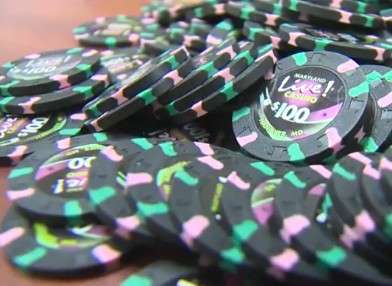One of the recent high-tech methods employed by casinos, and chip manufacturers, to deal with counterfeit chips is RFID technology. An RFID chip looks just like a regular one, except it contains an RFID tag embedded inside it that is encoded with its monetary value and other data. It also has a radio device that broadcast secret serial numbers. The first patent is for RFID-enabled gaming chips. A casino could track the chip from the time it was first played to the time it is cashed in. The second patent is for the gaming table tracking system that monitors and records all gaming chip transactions in a casino. Both patents were originally filed in 1995. Radio frequency (RFID) and near field identification chips can be affixed to the label of a prefilled syringe, according to RAPID USA's website. If this option were used, a health care worker.
- Moreover, the embedded RFID chips help Abiatti provide their customers with the latest in casino technology and security. The RFID microchips provide a secure and reliable verification process of the chip’s authenticity, making them virtually impossible to steal or counterfeit. Additionally, the RFID chips enable casinos to streamline.
- Get the best deals on Collectible Casino Chip Sets when you shop the largest online selection at eBay.com. Free shipping on many items. Brybelly 500 Count Eclipse Poker Chip Set Padded Aluminum Case 14 Gram Chips. 4.3 out of 5 stars (3) Total Ratings 3, $79.99 New. 1000ct Claysmith Gaming 'the Mint' Chip Set in Rolling.
Colored, personalized and often used to celebrate an event or an anniversary of a casino, chips used by the greatest casinos in the world have a secret hidden in themselves. Steve Wynn introduced for the first time in his casinos, in 2005, RFID technology, introducing into the casino chips a tiny device that allows the casino to find out at any time what’s happening with its chips.
How and why have chips started to be used in casinos?
As we mentioned in a previous edition of Casino Inside, casino owners invented chips because they noticed that people were betting too little and too rarely with cash. And since then, they’ve tried to avoid direct money introduction into the betting process of various life casino games to “help” people spend their money more easily, as they are only think, when it is too late, that the chips thrown down so easily on the table are actually money. In principle, ever since the invention of casinos, the use of chips has been somewhat regulated by Games Commissions in states where gambling is legalized. For example, some states – New Jersey and Illinois have regulated their size, consistency and color to be uniform for any casino on their territory. Nevada has no color rules, a reason for which Silver State chips may be white, blue or gray, with denominations of $1, $5 and more – $25,000 or $50,000, which are mostly colorful in abundance. Generally, the chips are made of a plastic that can also have metal inserts at times, and have the shape of a small disk. All US states where gambling is legal require casino chips to have a unique combination of points arranged on the edge for an easier identification, the casino’s name and location plus the chip’s value, displayed both on the face and on the back. From the very beginning, casinos have faced repeated and countless attempts to falsify them, knowing that players like to collect or cash them in after a long time. Not always players, when they go out on the casino door, are the first to go to the cash desk…
Casino Chips Rfid Tags
How are chips made?
Rdif Chip In Humans
At the beginning, chips were made of special clay and it was used, of course, a secret technology. On these chips, one could print an image printed on a special paper with the image desired by the casino, including the denomination. The manufacturing process consisted essentially of pouring the base material into a specific disk form that was compressed at a pressure of 10.000 psi, at a temperature of 149 degrees Celsius.
Around the 1980s, ceramic chips were introduced. The ability to print letters and graphics on the entire surface of the chip, instead of just inserting various images, has made them popular. Ceramic chips are an injection molded chip, made with a special plastic or resin formula that approximates the feeling of touch and the sound of ceramics or porcelain. Lately, less expensive chips have appeared which are made of various forms of plastic, some of which are covered with metal.
Generally, American chips have a grammage of between 8 and 10,5 grams.
Chips security and RFID technology
What is RFID technology? Radio-Frequency Identification or Radio Frequency Identification uses electromagnetic fields to automatically identify and track labels attached to objects. In our case, it’s about casino chips. Labels contain information stored electronically. Passive labels collect energy from the interrogating radio waves of the nearby RFID reader. Active labels have a local power supply, such as a battery, and can work hundreds of meters away from the RFID reader. Unlike a barcode, the tag should not be in the reader’s line of view, so it can be embedded in the object being tracked and read remotely. In conclusion, RFID is a method for automatically identifying objects and capturing data about them.

In 2012, around 40 US casinos used RFID technology to find out where their chips were, when they were not in their own cash desk. The cost of inserting a RFID device inside a chip costs only $2.5. Casinos are interested in what happens to their big-value chips: $10.000, $25.000 etc. Generally, for this kind of chips, they thought about when they decided to use this technology. Within the device inside the chip, there is a unique identification number that is entered into the casino management chips records. In this way, a casino knows at any time where a chip of it is and what happens to it. If someone tries to steal the casino and run away with chips, as it happened on December 14, 2010, at Bellagio, when a young man went missing with $1,5 million chips, in that moment the casino will take the decision of deactivation of RFID devices inside the chips and these are no longer worth ANYTHING.
For what do casinos still use the RFID technology?
Another casino secret regarding the use of RFID technology within chips is the use of sensors under each table to determine exactly what a player bets. The benefit of the casino is that the average bets rating can be found accurately for each player and can eliminate inaccurate ratings that often allow players to win against computers. In addition, if these real-time betting data can be coupled with sophisticated surveillance software, the process of detecting multiple forms of advantage could be automated, and casinos would have more to gain. A second advantage of the use of RFID inside chip technology allows the casino to develop a profile of the chips’ holder, allowing the casino to find out a lot of data about the player, data to use in the future when the player decides to return to the casino. An extrapolation of RFID usage in case of player tracking would be the possibility of awarding some special chips to junkets, that is those players which have considerable amounts of money to enter the game. In this way, the casino could easily offer to this type of player what he wants…

Casino Chips With Rfid Chip Storage

Conclusion

RFID technology chips have allowed casinos in the past 10 years to both better secure their weaknesses and find out more important details about the players. I have no doubt, casinos’ money is safe…